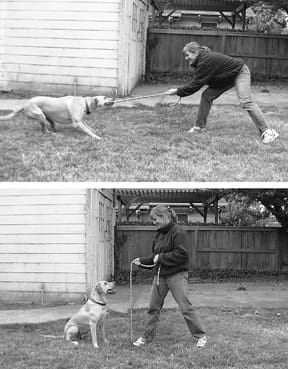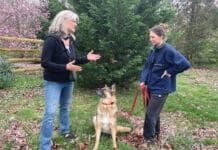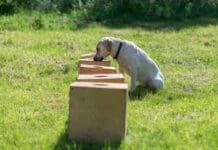by Pat Miller
Some trainers say you shouldn’t play tug with your dog. Not me! Those of you who enjoy this energy-eating aerobic activity with your dog will be pleased to know that I personally think it’s a fine game to play, as long as you’re using appropriate tug toys and playing with rules.
Tug, in case you’ve never had the pleasure of playing, is a fun and exciting game, in which you hold one end of a tug object while your dog pulls with all his might on the other end. Variations include dog-dog tug, tug human around on a wheeled object (such as an office chair), and self-tug (in which the dog tugs an object such as a Kong on a rope that is secured to a sturdy post or tree).
Arguments against tug
Here are a few of the reasons you may have heard for not playing tug with your dog, followed by my responses:
Reason: It encourages your dog to be dominant.
Response: It has nothing to do with dominance; it has to do with play and exercise. As with many other doggie games, you can easily create a structure that reminds your dog that you control the good stuff – in this case, the tug toy – which enhances your high-ranking position in the social structure, rather than undermining it.
Reason: It encourages your dog to be aggressive.
Response: Dogs can become very aroused playing tug. You can easily prevent this by stopping the game whenever your dog begins to become overexcited. Use a phrase such as “That’s all!” as you stop the game, and you will soon have a cue you can use in any situation where you want your dog to stop what he’s doing and calm down.
Reason: It teaches your dog to put his teeth on your clothes and skin.
Response: Dogs can make poor decisions about where to put their teeth when they’re engaged in a rousing game of tug. You can use this perfect opportunity to decrease the likelihood that your dog will bite in play by teaching him that teeth on human skin makes the fun stop. If you say something cheerfully (such as “Too bad!”) and call a short time-out anytime your dog’s teeth stray into forbidden territory, it will teach him to keep his teeth to himself.
Arguments for tug
And now, my far more numerous reasons for playing tug with your dog:
• It’s great exercise. It’s a lovely indoor activity, perfect for relieving pent-up energy for a dog who’s shut in on a stormy day, or a sub-zero winter week. A low-key version of the game is also useful for occupying a dog who’s on physical restriction following surgery or an injury.
• It can be used to teach retrieve. A dog who is less-than-enthusiastic about putting retrieve objects in his mouth can sometimes be motivated to do so by encouraging him to play tug. When he gets aroused about tugging, you take advantage of his enthusiasm to shape the retrieve.
• It can be used to teach recalls. Is your dog less-than-sterling about coming when called? Get him hooked on tug – then stick a tug toy in your pocket when you go hiking. When he’s a short distance from you, call him, show him the toy, and watch him beeline back to you for a tug session. Stick the toy back in your pocket (or pack), let him wander off a bit again, and repeat.
Stop before he’s tired of tugging, so he’s always strongly motivated to return. Practice this with your dog on a long line at first, to be sure it will work! (See “Long Distance Information,” WDJ February 2001.)
• It’s a useful distracter. Lucy, our new Cardigan Corgi, used to take delight in tormenting our Scottie, who hikes with me on a long line because his recall is not reliable. The long blue leash snaking through the grass would catch Lucy’s eye, and she’d latch onto it and drag poor Dubhy around.
A tug toy was perfect for redirecting her desire to grab and pull his leash. (I may, however, teach her to grab his leash and bring Dubhy back to me on those occasions when the recall doesn’t work!)
• It can be a stress reliever. Many dogs develop a very positive association with the tug game.
One of my clients discovered a great application for tug while trying to do counter-conditioning and desensitization (CC&D) exercises in public with her dog- and people-reactive Briard. When the stimulus (a dog and/or person) occasionally and unexpectedly presented itself too closely, Jobie was too stressed to take treats. Terry discovered she could whip out a toy for a gentle game of tug, use her dog’s positive association with the tug game to reduce his stress enough to the point he would eat treats and then resume the CC&D.
• It’s great for teaching self control. As discussed in “arguments against,” tug is a perfect activity for teaching your dog to control his energy and mouth placement, by teaching an “All done” cue to end the game, and using a “Too bad!” time-out when canine teeth touch human skin or clothing.
• It can be a “legal” outlet for roughhousing. There is often at least one family member – usually male – who delights in playing rough physical games with the dog. Physical games that encourage body-slamming and mouthing do tend to reinforce inappropriate behaviors. Convince your roughhousing humans to play tug by the rules, and they’ll help you reinforce desirable behaviors instead, while fulfilling their need to get physical with the dog.
• It can build relationships. Doing things that your dog loves helps build a strong bond between you two. Playing tug with a dog who loves it can reinforce his focus on you, and his interest and pleasure in playing and training with you. While food rewards are an important part of positive training, life rewards – activities that are meaningful and reinforcing to the dog – strengthen the relationship and give you options for using other rewards in addition to treats.
Rules of the game
These are general guidelines for making tug a positive training/relationship experience. The calmer and better-behaved your dog is, the less necessary it is to follow the rules strictly. The more rowdy and out of control your dog, the more closely you will want to adhere to them. By the way, don’t be alarmed by your dog’s growls during tug – it’s all part of the game. As long as his other behaviors are appropriate, let him growl his heart out!
• Rule #1: You start the game. Keep the tug toy put away, and get it out when you want to play. It’s perfectly okay to get it out when you know he is in the mood, but it’s your choice to start the game. You control the good stuff.
• Rule #2: No grabbing. Hold up the toy. If your dog grabs or leaps for it, say “Oops!” and hide it behind your back. Then offer it again. When he is no longer keeping or grabbing, say “Take it!” and offer his end to him. Then give him the cue to “Tug!” or “Pull!” and the game is on. You control the good stuff and allow him to have it out of the goodness of your heart.
• Rule #3: You win most of the time. “Winning” means you have the toy and your dog doesn’t. At first, you may need to offer him an irresistible treat as you say, “Give!” He’ll have to drop the toy to eat the treat, and you’ve won! As soon as he devours the treat, say “Take it!” again and offer him his end of the toy. Now he got two rewards for letting go of it – he got the treat, and he gets the toy back again! At least, he gets his end of the toy back. Practice the “Give” part of the game numerous times during each play session. Eventually you will be able to fade the use of the treat, as he realizes that the reward for “Give!” is more tug.
• Rule #4: Use time-outs as needed. If your dog gets too aroused and/or is putting his mouth on you or your clothing, use a “Too bad, time out!” when his arousal level starts to escalate to an unacceptable level, or the instant his teeth touch forbidden surfaces. Put the toy high on a shelf and sit down for a few minutes. Then you can, if you want, retrieve the toy and play again.
If you have a dog who allows his teeth to stray into forbidden territory frequently by creeping his jaws up the length of the toy, use a tug object with a clear demarcation near his end of the toy – a change in texture or material – and do a time-out immediately anytime his teeth cross that line. You control the good stuff, and his inappropriate behavior makes the good stuff go away.
• Rule #5: Supervise children. Very young children should not play tug with your dog unless and until the dog is impeccable about his self-control, and then only under direct supervision. Middle to older children can play with moderate supervision if they can be relied on to play by the rules, and if your dog is under reasonable self-control and not likely to get into trouble. Children can control the good stuff too!
• Rule #6: You end the game. You get to decide when tug is over, not your dog. End the game with a “Give, all done!” cue and put the toy away on a high shelf or in a secure drawer. It’ll be there, ready and waiting, when you decide to play tug again. You control the good stuff.
Variations on the theme
The most common style of tug consists of a dog on one end of the toy, a human on the other. You don’t have to stop there, however. If you have two compatible dogs who love to tug you can give them each one end of a toy and let them go at it with each other.
The key word here is compatible. Because tug does create a certain level of arousal, dogs who are prone to getting into fights should not be encouraged to tug together. Don’t equate growling and snarling with fights, however – a lot of that will go on when compatible dogs play tug together.
If you have two dogs who can tug together, try a threesome! Find a tug toy with one handle for the human and two ends for the dogs – a game the whole family can play!
At the other end of the spectrum, you can teach your dog to play tug by himself. You can run a rope through a Kong and knot it so the knot is inside the Kong, and then tie the other end of the rope to something sturdy. Encourage your dog to pick up the Kong and pull on the rope.
There are also a number of toys on the market that are made with elastic bands inside, meant to encourage a tug-loving dog to pull harder and longer, even when there is just a tree or a post, not another playmate, on the other end of the toy. Of course, you lose the relationship value of tug with this variation of the game, but you might increase the exercise benefits!
-Pat Miller, CPDT, is WDJ’s Training Editor. She is also author of The Power of Positive Dog Training, and Positive Perspectives: Love Your Dog, Train Your Dog.







Great article! But my question relates to Rule #4 and Time Outs: When the dog is highly aroused and needs a time out, HOW DO YOU GET THE TUG TOY BACK FROM HIM AT THAT POINT? I wish that you would have addressed this. Because if I ask him to “Give” me the toy back at that point, he most likely won’t (because he’s too aroused) and if he does (by the grace of God) then I would treat him and he wouldn’t understand the “Time Out” que.
My rescued husky doesn’t seem to know how to play with – well – anything. Won’t place items in mouth or carry them in her mouth. Doesn’t chase balls or sticks for fun. Has no special toy or object she loves. She sometimes gets the Zoomies after coming inside from the back yard on a chilly day. Seems to understand I want to pay when I get on all fours and lower just my elbows and chest to the floor while keeping my hips raised and wiggling them like a wagging tail and she will sometimes get into same position and get excited but not very often or for very long.
I have given her a stuffed animal that we call pandy bear and hide a treat between the toys arms. And tell her to go get Pandy bear and your treat. Pointing it out to her. She knows the toys name and understands it is hers and sometimes will guard it when the cats walk by. But otherwise nothing. We’ve tried various toys. She just didn’t come with that skill. I couldn’t get her to carry it or pick it up with her mouth. A couple of times she would if she knows there’s s treat inside.
By the way, she’s also not good with other dogs around. Warns them off with a growl and show of teeth. Had attacked other strange dogs. At obedience class as long as dogs kept their distance she was okay with them. But not if they get too close.
It’s like she never got to play as s pup.
(Btw, her DNA kit verified she is 100% Siberian Husky, white with blues, and stocky and stubborn.
Any idea how to teach her to play?
My rescued husky doesn’t seem to know how to play with – well – anything. Won’t place items in mouth or carry them in her mouth. Doesn’t chase balls or sticks for fun. Has no special toy or object she loves. She sometimes gets the Zoomies after coming inside from the back yard on a chilly day. We’ve tried various toys. She just didn’t come with that skill at all.
By the way, she’s also not good with other dogs around. Warns them off with a growl and show of teeth. Had attacked other strange dogs. At obedience class as long as dogs kept their distance she was okay with them. But not if they get too close.
It’s like she never got to play as s pup.
(Btw, her DNA kit verified she is 100% Siberian Husky, white with blues, and stocky and stubborn.
Any idea how to teach her to play?
Why won’t our rescued dog play with – well – anything. Won’t place items in mouth or carry them in her mouth. Doesn’t chase balls or sticks for fun. Won’t tug. She sometimes gets the Zoomies on a chilly day. She just doesn’t get it.
Shes also not good with other dogs around.Has attacked other strange dogs. At obedience class as long as dogs kept their distance she was okay with them. But not if they get too close.
It’s like she never got to play as s pup.
(Btw, her DNA kit verified she is 100% Siberian Husky, white with blues, and stocky and stubborn.
Any idea how to teach her to play?